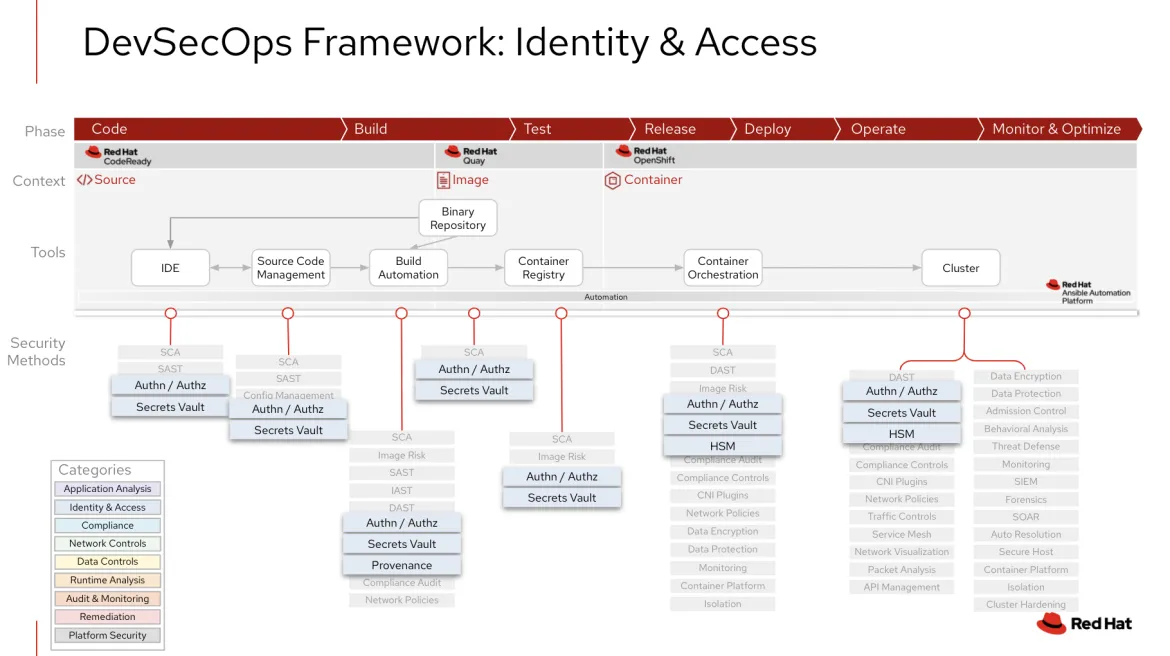May is Identity and Access month in the Red Hat’s monthly Security series! Beginning in March 2021, the Red Hat Security Ecosystem team has provided an introduction to a DevOps Security topic in a regular fashion to help you learn how Red Hat weaves together DevOps and security to help master the force called DevSecOps. We explain how to assemble Red Hat products and our security ecosystem partners to aid in your journey to deploying a comprehensive DevSecOps solution.
Identity and Access defined
Typically when identity and access is mentioned in a Kubernetes context, it’s IAM, or Identity and access management. These security methods control access to on-premises and cloud assets, applications, and data based on user or application identity and administratively defined policies. They are found in every stage of the DevOps lifecycle and can help protect against unauthorized system access and lateral movement. Taking a look at the different methods in Identity and Access, the following become a distinct, but related list:
-
Authentication is verifying the identity of users, services and applications.
-
Authorization is granting the authenticated users to specific resources or functions. In Kubernetes context, this is commonly referred to as role-based access controls (RBACs), which grant collections of users access to resources or functions based on their job responsibilities, simplify administration and onboarding, and reduce privilege creep.
-
Secure identity storage, such as secrets vaults and hardware security modules (HSMs), which manage and safeguard security credentials, keys, certificates, and secrets while at rest and in transit. HSMs are typically a physical device which securely stores digital keys through encryption to protect sensitive data. Secrets Vaults are typically a software solution that securely stores and manages any type of secret, like tokens, passwords, certificates, and encryption keys.
-
Provenance, which in the context of containers, is the ability to verify the identity or authenticity of code or an image typically through some type of digital signature or attestation record.
Identity and Access integrated in DevSecOps
As seen in the DevSecOps framework below, Identity and Access is represented in each integration point in the life cycle. This makes sense as identity needs to be managed properly in each step of the way in DevOps.
 The table details some, but not all, of the common items to consider for identity and access in a DevSecOps life cycle.
The table details some, but not all, of the common items to consider for identity and access in a DevSecOps life cycle. |
Integration Point |
Description |
|
IDE |
Centrally provide IDE access to developers and ensure they only have access to development projects they are authorized to work on. Red Hat CodeReady Workspaces uses RH-SSO to create, import, manage, delete, and authenticate users. It can use third-party identity management systems, like a secrets vault, to create and authenticate users. |
|
Source Code Management |
You want to ensure the right people have access to the right source code repositories and only allow commit permissions to code contributors. In Red Hat OpenShift, Identity Providers like GitHub and GitLab can be configured to access the SCM. Secrets Vaults extend this capability by centrally managing SCM access tokens or secrets. |
|
Build Automation |
Developers don’t need edit access to the build system as builds should run automatically on a scheduled basis or per commits. With OpenShift Pipelines being part of Red Hat OpenShift, the default RBAC capabilities can be leveraged to allow specific permissions to the pipeline projects. Base images can be checked during the builds to ensure they come from trusted repositories and their checksums match with the distributor. |
|
Binary Repository |
Authentication and Authorization is a key consideration for Binary Repositories ability to stage or cache 3rd party dependencies from external sources to prevent users from using untrusted code in their applications. |
|
Container Registry |
Follow a zero trust methodology to harden your container registry access as it is a critical part of the DevSecOps development cycle. With Red Hat Quay, you can remove anonymous access, integrate with an Identity Provider, and create Robot Accounts which allow specific fine grained permissions to specific repositories. |
|
Container Orchestration |
In addition to user authentication and authorization to deploy and test container images, pod permissions are an important consideration in this step, especially if pods need to reference images across projects, from secured or private registries. Using image pull secrets with a centralized secrets vault is a best practice. |
|
Cluster |
Red Hat OpenShift Container Platform provides foundational Identity & Access features by integrating with Identity Providers, multi-tenancy with Project namespaces, and RBAC turned on by default. In addition to cluster user access, secrets vaults provide essential functions for running applications, such as on-demand access to passwords for application services like databases. An HSM can be used to protect and store cryptographic keys with industry standard, tamper-resistant hardware so that applications can access sensitive data without getting direct access to the encryption keys. |
Enhance and Extend Identity and Access with Red Hat Partners
Combining Red Hat OpenShift Container Platform identity and access features with Red Hat’s certified Ecosystem Security Partners provides holistic enterprise-ready DevSecOps. If you are looking to enhance and extend Red Hat’s security capabilities in Identity & Access, take a look at the following Red Hat Partners:
-
Cyberark’s certified software and webinar.
-
Thales’ Red Hat solution brief and webinar.
For more information, visit "Modernize and secure applications with DevSecOps," or talk to us at Enhance container security and adopt DevSecOps.
저자 소개
Dave Meurer currently serves as a Principal Solution Architect on the Red Hat Global Partner Security ISV team, where he owns technical relationships and evangelism with security independent software vendor partners of Red Hat. Before joining Red Hat, he spent nine years in the Application Security industry with Synopsys and Black Duck, where he served in similar roles as the director of technical alliances and sales engineering.
Meurer also worked for Skyway Software, HSN.com, and Accenture in various management and application development roles. When he’s not thinking about Kubernetes, security, and partners, he enjoys being the VP Sales of North Central Tampa for his wife (the CEO) and 5 kids (Inside Sales).
채널별 검색
오토메이션
기술, 팀, 인프라를 위한 IT 자동화 최신 동향
인공지능
고객이 어디서나 AI 워크로드를 실행할 수 있도록 지원하는 플랫폼 업데이트
오픈 하이브리드 클라우드
하이브리드 클라우드로 더욱 유연한 미래를 구축하는 방법을 알아보세요
보안
환경과 기술 전반에 걸쳐 리스크를 감소하는 방법에 대한 최신 정보
엣지 컴퓨팅
엣지에서의 운영을 단순화하는 플랫폼 업데이트
인프라
세계적으로 인정받은 기업용 Linux 플랫폼에 대한 최신 정보
애플리케이션
복잡한 애플리케이션에 대한 솔루션 더 보기
오리지널 쇼
엔터프라이즈 기술 분야의 제작자와 리더가 전하는 흥미로운 스토리
제품
- Red Hat Enterprise Linux
- Red Hat OpenShift Enterprise
- Red Hat Ansible Automation Platform
- 클라우드 서비스
- 모든 제품 보기
툴
체험, 구매 & 영업
커뮤니케이션
Red Hat 소개
Red Hat은 Linux, 클라우드, 컨테이너, 쿠버네티스 등을 포함한 글로벌 엔터프라이즈 오픈소스 솔루션 공급업체입니다. Red Hat은 코어 데이터센터에서 네트워크 엣지에 이르기까지 다양한 플랫폼과 환경에서 기업의 업무 편의성을 높여 주는 강화된 기능의 솔루션을 제공합니다.

